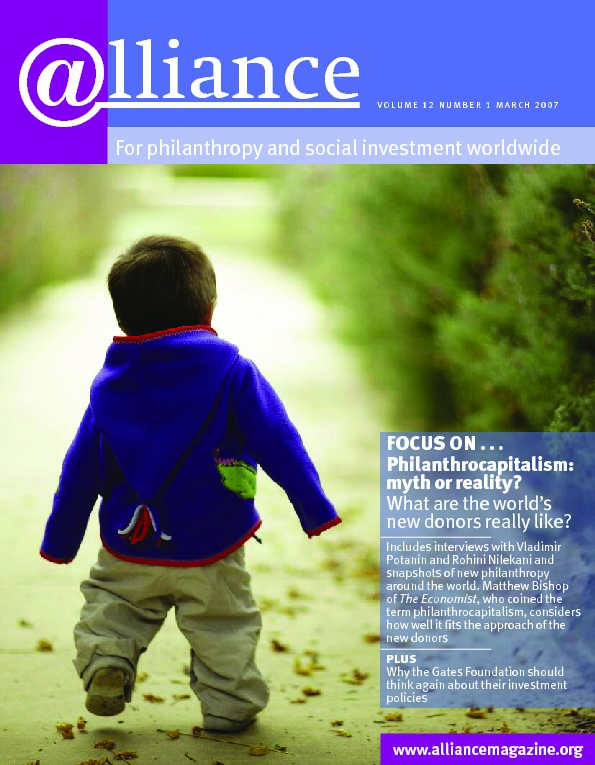The arrival of new sources of funding is always welcome news to anyone concerned with the application of private wealth to the benefit of society. The influx of vast new wealth into the non-profit sector represented by the ‘new philanthropy’ highlighted in this issue of Alliance is no different. Its appeal derives both from the added financial resources and from the energy that new donors bring to the non-profit world.
Not so welcome, however, are the less desirable characteristics of the new philanthropy. In their rush to embrace novel and exciting approaches, some new donors forget that philanthropy is about much more than strategies of social problem-solving or the ‘effective investment’ of funds. Indeed, the practice of philanthropy has a very long history – reflected in the word’s Greek origins – that is closely bound up with the complex unfolding of human social and political development over more than two millennia. Philanthropy has provided not only a mechanism for channelling money to social problems, but, more important, an essential medium for realizing human values and aspirations.
It is vital to understand what is at stake in contemporary arguments about the purpose of philanthropy. Much of what the debate is about is conveyed in the rather unlovely term ‘philanthrocapitalism’, coined recently by The Economist to characterize some modern approaches to the field. It refers to the direct application of the techniques of business investment and market mechanisms to the world of philanthropic activity. While proponents of such an approach extol its emphasis on strategic, highly managed, results-oriented use of funds in solving social problems, I suggest that such a view is both ahistorical and lacking in understanding of the multi-layered social fabric in which philanthropy is an integral thread.
The view is ahistorical because it assumes that 21st century globalized market behaviour provides the definitive universal framework for understanding life in society. Even a casual reading of history reveals that philanthropy takes on quite different meanings when applied in particular situations with specific intentions: whether for building aqueducts, celebrating memorial masses, assisting the poor, constructing hospitals, caring for orphans, ensuring religious salvation, dedicating museums, educating apprentices, abolishing slavery, eradicating diseases, supporting artistic genius, or finding asteroids. When people give money or volunteer time to their preferred causes, they do so for wildly different reasons related to the values and conceptual assumptions of the historical environments in which they find themselves.
The philanthrocapitalism view is narrowly one-dimensional because it seeks to impose a model of one part of a social system onto another, a model similar to the failed social engineering schemes of the past. To inject a certain quantum of money into a social problem with the expectation of producing a corresponding quantum of results is to assume a highly simplified world of inputs and outputs. Social reality consists of a bewilderingly complex network of individuals and groups pursuing radically different interests and visions. To work successfully in this environment requires an approach that looks more like negotiation among diverse groups in a democratic society or a family decision-making process than a ‘bang for the buck’ investment decision. And this conceptual complexity only builds upon the well-known problems of impossibly numerous variables, long time horizons, and indeterminate chains of social causality.
I was dismayed, therefore, to read in a recent article in the New York Times that the new philanthropic style of the young billionaires – complete with its philanthrocapitalistic mantras of ‘focus’, ‘effectiveness’, ‘consolidation’ and ‘speed’ (measurable results within three to five years) – is beginning to set the trend for the entire field.
That brought to mind another profound Greek word, hubris, an instructive concept for everyone who exercises the power of philanthropic wealth. The Greeks understood that antidotes to the dangers of hubris are to be found in the qualities of humility, responsiveness and listening – and history teaches us that these, rather than managerial efficiency and productivity, are the qualities that modern philanthropists would do well to cultivate.
Bruce Sievers is a Visiting Scholar at Stanford University and former Executive Director of the Walter and Elise Haas Fund. Email brsievers@onemain.com



Comments (0)